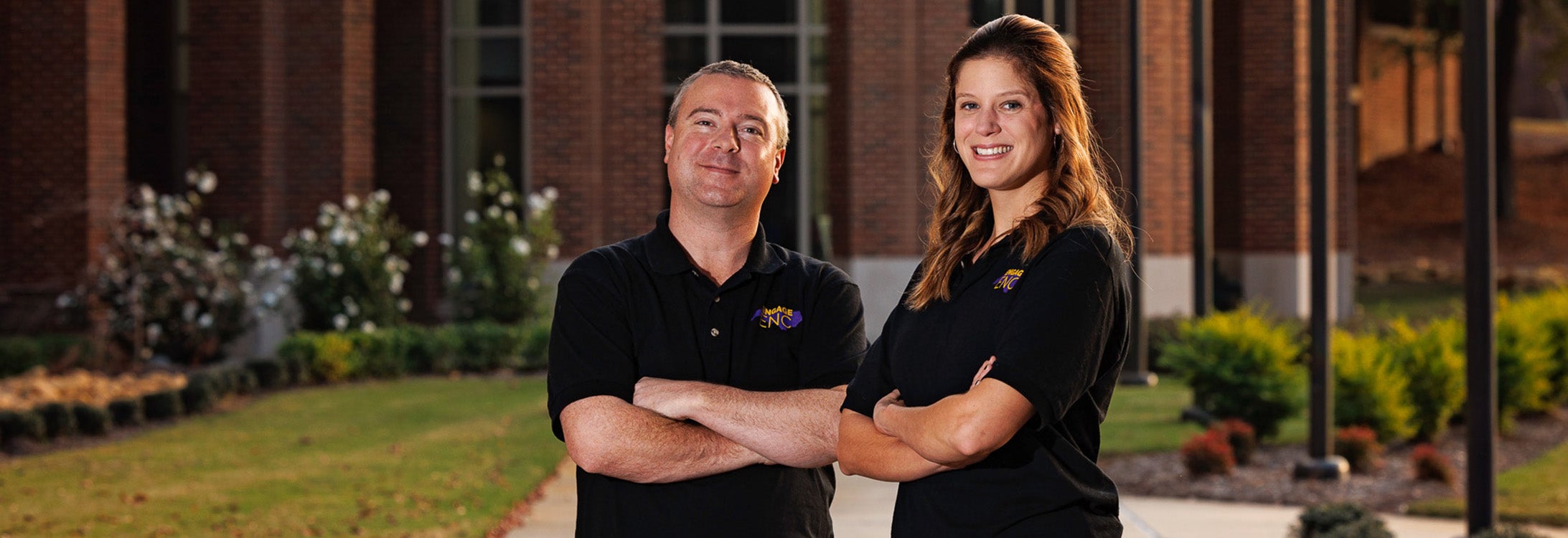RECOVERY GRANT
ECU program aims to limit impact of addiction, HIV
Dr. Leigh Atherton, an associate professor in East Carolina University’s College of Allied Health Sciences, has a simple-sounding proposition — engage individuals who are being tested for HIV to gauge their need for, and willingness to accept, treatment for substance use.
It’s a win-win from a public health standpoint, but only if the people are willing — and Atherton and his team in the College of Allied Health Science’s Department of Addictions and Rehabilitation Studies can reach them.

One in four Americans do not know their HIV status and engaging in risky behaviors, like unprotected sex and sharing of needles, leads to greater risk. (Contributed photo)
Atherton’s program, Engage Eastern North Carolina, has embarked on a $2.5 million dollar federally-funded project to find and engage members of underrepresented communities with expanded HIV testing and information about substance use recovery in the hopes of reducing the occurrence of each in rural North Carolina.
The new HIV outreach program is part of a broader effort to expand behavioral health treatment across rural North Carolina. Atherton and his team have worked for years on a grant-funded program that engages prisoners, and those recently released from incarceration, to keep them in addiction treatment and help them find employment and a stable, drug-free path forward in their lives.
“For the purpose of this grant, we’re going to be looking at the large African American and Hispanic populations that are high risk for substance use and for HIV or hepatitis,” Atherton said.
While the numbers are generally trending down for newly diagnosed HIV cases for women in North Carolina from 2016-20, infection rates fluctuate around a steady level for men. The NCDHHS report cautions that figures for 2020 are likely skewed lower by the COVID-19 pandemic.
Community partnerships
The HIV outreach grant allows Atherton, fellow faculty members and ECU students to supplement existing community-based HIV and addiction outreach efforts through three lead prevention providers with HIV testing equipment — the Pitt County AIDS Services Organization (PICASO), the Beaufort County Health Department and the Lenoir County Health Department. The program also partners with the ECU Adult Specialty Care Clinic in Greenville, the primary HIV care provider for approximately 1,800 patients living in 28 eastern North Carolina counties.
By redoubling the efforts of partner outreach groups, Atherton says that his addiction-focused program is given greater access to community members who are in the throes of addiction battles that put them at greater risk of contracting, and possibly spreading, communicable diseases.
“We will engage various community partners and the health departments, they’re doing the work,” Atherton said. “Our staff will connect with the health departments, at say a needle exchange program, and engage racial ethnic minorities that are interested in a substance use conversation who are at that health department-sponsored event.”
Along with extra testing supplies, the grant funding will pay for staff and faculty who can be on the front lines engaging with people dealing with substance use concerns.
“At the state level with HIV and hepatitis outreach, one thing that they’ve wanted to add for a long time is substance use screening, and they just haven’t had the funding to hire and train the right individuals to do it,” Atherton said. “So that’s where our project can add, hopefully long term, but for at least the next five years.”
Benefits for community
Atherton and his team are approaching this possibility in the same way that they do all opportunities to engage those struggling with addiction — with eyes wide open and plenty of patience.
Some individuals are interested in knowing their HIV or hepatitis status, Atherton said, and take advantage of the free testing offered by outreach groups. Others are specifically seeking out help for substance use problems. Regardless of how people get in the door, Atherton and his team use the opportunity to engage them with a brief substance use intervention.
When Sara Coltrain, a doctoral student in the Department of Addictions and Rehabilitation Studies from Lumberton, worked in New Bern, she met only a handful of people who had tested positive for the virus. Awareness of, and education about, STDs and HIV was not prevalent in the patient population she worked with.
“Sure, HIV isn’t quite as prevalent as it used to be, but it’s still very real. Hepatitis C is very, very real right now,” Coltrain said, which is why offering testing, which might also lead to addiction treatment, is so very important for eastern North Carolina.
Brody School of Medicine’s Dr. Jeff Thomas directs the Ryan White Program in the Division of Infectious Diseases at the ECU Adult Specialty Care Clinic. The grant-funded program, administered by the Health Resources and Services Administration, provides core medical and support services to people living with HIV.
One in four Americans do not know their HIV status, Thomas said, and if those people are engaging in risky behaviors like unprotected sex and sharing of needles, they create two levels of risk — the spread of HIV and other sexually transmitted infections from one person to another and potential additional financial costs passed onto taxpayers for individuals without insurance.
“From an epidemiological standpoint, the National End the Epidemic goals for 90% of people living with HIV to know their status; 90% to be virally suppressed, and 90% to be retained in care are critically important. Our communities are healthier through testing efforts to reduce the spread of HIV and when people living with HIV are in care,” Thomas said.
While the stigma around being HIV positive has decreased over the past few decades, Atherton said that the stigma still exists — and can be used as a way to potentially get substance abusers to consider treatment, which is the long game that Atherton and his partners use to make drug treatment and recovery more enticing.
“Research shows that using a brief intervention model during these points of entry has a higher than doing nothing chance of engaging (substance users) in treatment,” Atherton said.
Risky substance use, and the behaviors that swirl around that risky drug use, put individuals at a higher risk of contracting bloodborne pathogens. A person knowing their HIV status activates that nagging voice in the back of your mind that can get them to reconsider their actions, particularly with risky substance use behaviors.
“If I recognize a consequence to my action, then it’s harder to engage in that action,” Atherton said. “So, if I don’t put my head in the sand and if I’m not able to ignore or defer recognizing those potential consequences, then it’s harder to keep doing that behavior. Having that brief intervention may not be fruitful in that moment. But a week, two weeks down the line, we end up getting calls back saying ‘I’ve been thinking about it and I need to do something.’”
How often do these follow-up calls happen? Atherton estimates about half the time and telehealth is increasingly embraced after the COVID-19 pandemic forced everyone to change communication habits.
Atherton believes that reservations that many have had about speaking with counselors over the phone or through video chat may be melting away, particularly with digitally adept generations and individuals who might be more willing to open up with a layer of anonymity, even if that anonymity is merely perceived.
Access to telecommunications is a challenge in eastern North Carolina, particularly in the most rural counties in the extreme northeast corner of the state, but researchers are finding the physical barriers, as well as barriers to willingness to use telehealth for counseling, are beginning to crumble.
Teaching students
The Engage Eastern North Carolina outreach events offer ECU’s Addictions and Rehabilitation Studies students exceptional opportunities to see first-hand the complexities involved in working to treat both addiction and physical health concerns. By putting students into real-world, life and death situations for potential clients, students can begin to process the complexities those patients must wade through in order to make decisions about their physical and behavioral health.
“Engaging potential clients, whose motivations for changing are varied, truly helps counselors-in-training grow a better perspective of what their role is as a counselor. Where, as a counselor, the goal is not to ‘get someone to change,’” Atherton said. Atherton believes the best strategy is “to help someone explore their thoughts about a change and guide them through a path they choose.”
Through working in Craven County, Coltrain learned that eastern North Carolina suffers from a pronounced lack of health care access, but particularly to behavioral health and addiction services, and that the region’s counselors get burned out.
Coltrain is heavily involved with the inmate engagement arm of Atherton’s Engage North Carolina program but has been involved in the planning for the HIV outreach initiative as well. She said that much of society regards those with addiction problems and stigmatized diseases.
“You’re a person. You are, unfortunately, a person who got dealt a really tough hand and you have a hard time cashing them in to get new cards,” Coltrain said, which is what she tries to impart to the students she teaches in the addiction and recovery programs.
To be a successful counselor, one needs to recognize biases and check those biases at the door when dealing with clients.
Hope
Atherton sees hope, both for reducing the HIV infection rate in the state as well as getting individuals who use substances to consider getting treatment.
“I love working with those who are on the fence — ‘do I want help or not? Do I want to keep using or do I want to get into services and being part of that process?’ Not only to help them make that transition, but to let them know that it’s okay not to want to change right now, but that we’re here when if or when they want to,” Atherton said.
While the make-the-offer model of discussing treatment with individuals who use substances, with the hope that the individual will accept treatment in the future, might not address our desire for immediate results, Atherton said that research shows it is the best strategy.
“We can build the best treatment,” Atherton said, “‘If you build it, they will come’ isn’t enough — you need to go out and engage them to help them enhance their motivation to want to enter treatment, to keep them safe and to make different choices.”
